I take a step forward. One more. My nose is centimetres from the canvas now. I involuntarily raise my hand to the crown of my head. Scratch and part the hair slightly. I find what I’m looking for. The scar that is only known to me and my barber. I rub it slightly, fingering the mark where no hair has grown since that fall in the garden as a toddler. An infant wailing, bleeding; patched up, kissed better; days later, congealing, mending. Why am I remembering this now? The painting. Secundino Hernández’s painting, in his studio. A painting in which there’s a similar scar. Similar scars, scratching away the surface of the paint, revealing the raw canvas. The skin of the paint.

Hernández is not a painter who aims for politeness in his work.
Hernández works in series, producing bodies of paintings that explore not just their own process of production over multiple iterations but, when massed together, ask us to restage and retest our method of looking, questioning how we see these painted surfaces. In the studio, with its concrete floor and vast height, I am studying one of what might be termed his ‘wash’ works.
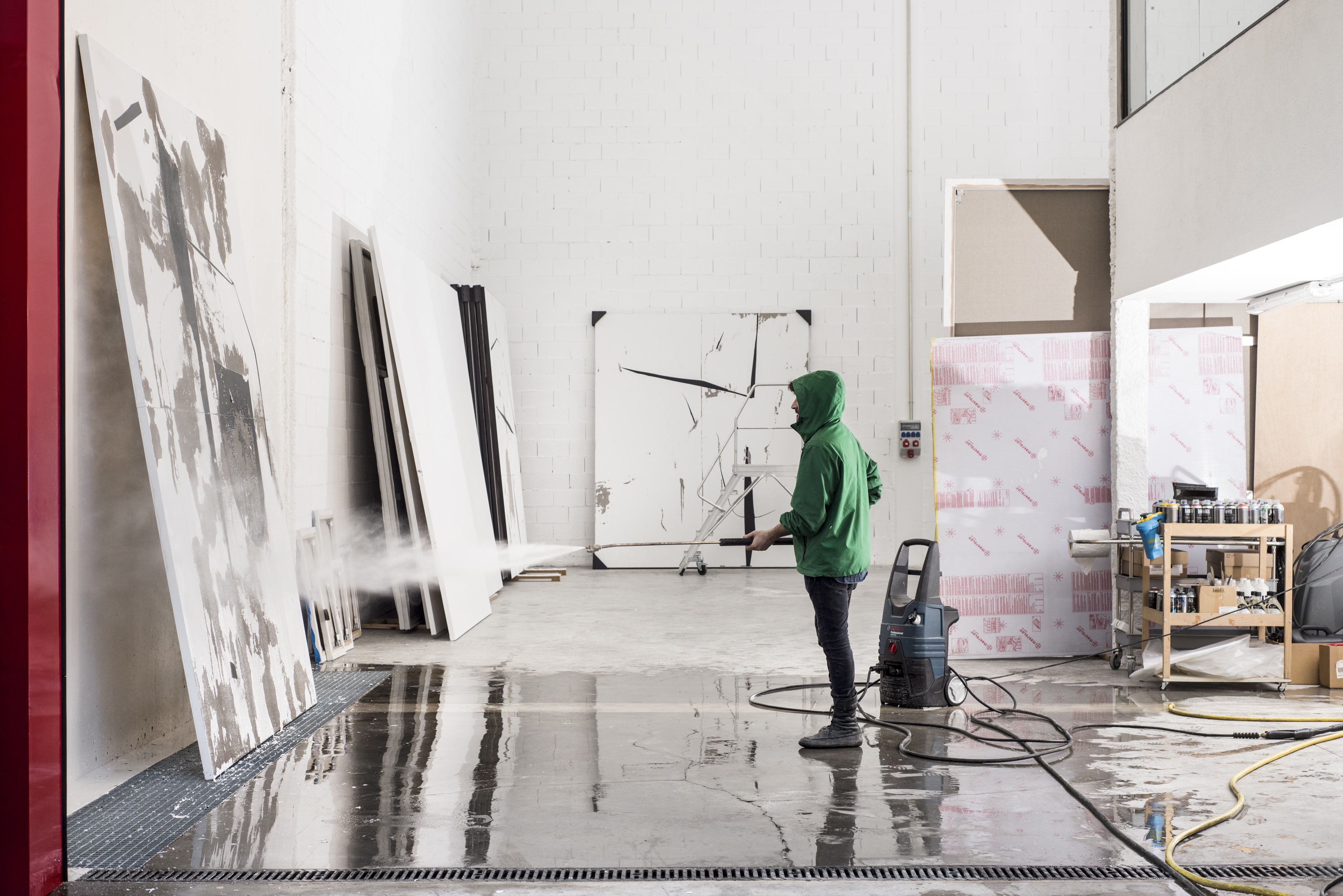
These paintings are made in two stages. First Hernández will paint a canvas white (or more often, multiple canvases attached together, given the scale the artist is prone to work on.) Across this brilliant surface he strikes a series of black angular marks. The result of this initial action is minimalist, if perhaps polite, geometric abstraction. The markings have a cool precision to them. The lines are crisp. The monochrome seductive. Hernández is not a painter who aims for politeness in his work, however. For this we can be thankful. Parked nearby are two industrial pressure hoses. Taking the hoses, with an energy that recalls the performativity of action painting, the artist will tear into the surface. Torrents of water hit the paint with startling violence, Hernández’s control of this jet ambiguous.

Hernández’s work evokes a revolutionary instant.
Gashes stretch over the now ‘ruined’ composition. At other moments on the canvas the ‘damage’ is lighter and more casual, the gradients of abrasion varied. The aesthetic born of these creative bouts of damage is not one that feels kinship with the sanctified space of the galley or the carefully designed domestic interior but are weathered and worn, recalling perhaps instead the rough, lived, life of the street. These street tough works, despite their size, beg us to step closer. The drama of Hernández’s painting is often most intense in the detailing (we can recall Mark Rothko’s note ‘I paint big to be intimate.’) A small section of Untitled, 2017, is typical. Wrinkled, carried up from the canvas surface by the power of the jet spray, is a wave-like flap of paint. It curls over and – get really close – the viewer can see the layering of the black paint on the outside, now folded inwards, and the underside skin of white paint, both lifted away and stuck protruding out towards us. Elsewhere the painted white surface bulges and buckles. The black painted marks sag and sway. A thousand and more speckles of paint – shrapnel from the explosion wrought onto the painted surface by the hose – invade the entire surface of the work. In a fashion it harks back to the disturbed surfaces of Alberto Burri’s sacking works of the 1950s, in which the Italian artist inserted wire behind stretched cloth, causing swelling and protuberances. There is certainly something sculptural about the tiny moments in Hernández’s painting too – little dramas, never identical, replicated again and again within the disarrayed paint – yet the word ‘sculptural’ suggests too much prescription on the part of the artist. Unlike Burri, who engendered his work with a sense of age by choosing cloth beset with holes and frays, Hernández’s work evokes a revolutionary instant. Within the parameters of his unique process, there is a mad freedom to Hernández’s paintings, one that operates beyond the restraints of authorial control.

Were one to look for further art historical lineage, the chance abstraction of Jackson Pollock or the violent slashes in Lucio Fontana’s Tagli series (1958–1968) are apt in relation to the production of the work. Standing in front of these towering canvases however it is another painter, of a much older generation, that is recalled. For the viewer, the artist’s surfaces feel kinship with the turbulent mark-making of a JMW Turner seascape. Like that of the English eighteenth century landscapist, Hernández’s work evokes the same loss of control as one is submerged into the painted surface, a sublime overwhelming, a surrender to the elements and all the scarring that brings forth.

As he does with the ‘wash’ works, Hernández reminds us that paint is primarily a building material and the event of painting is that of the construction of surface, but also off the surface.
If the ‘wash’ paintings can be thought of as cuts or abrasions to the skin of the paint, then one might liken Hernández’s second avenue of production, in which he heavily builds up an intense impasto-like painted surface, to the paint clotting. Surveying these lumpy, mountainous works, we naturally reach for all sorts of onomatopoeia. Gloopy, gooey, glunky. Mucky, murky, molten. As he does with the ‘wash’ works, Hernández reminds us that paint is primarily a building material and the event of painting is that of the construction of surface, but also off the surface.
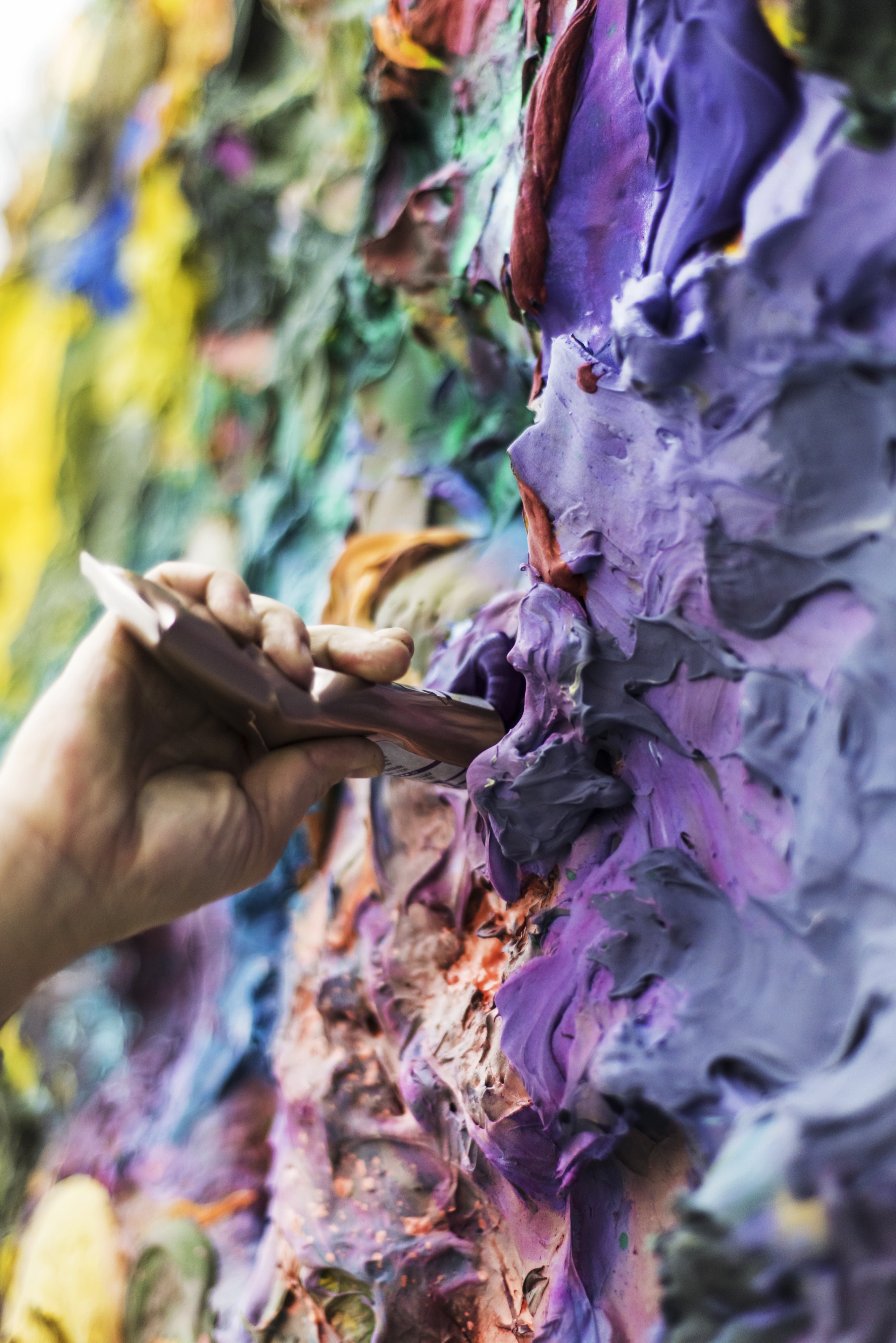
During its production Untitled, 2017, colonised the floor of Hernández’s studio; hung on the gallery wall the eyes are left to wander this landscape up close, following and losing oneself in its ravines, pools and caverns of multicolour. There is natural tendency to relate this work – which the artist refers to as a ‘palette’ painting – back to second generation abstract expressionism, yet Hernández’s practice here is less a statement of the autobiographical gesture, than a construction of autobiographical process. In part Untitled can be considered a diary of the studio: much of this amassed mix of acrylic, oil and alkyd paint moulded and mashed onto the reinforced canvas is left over from other paintings (Hernández is prone to work on several simultaneously at any one moment). On coining the term ‘action painting’ in 1952 critic Harold Rosenberg noted painting as becoming ‘an arena in which to act… what was to go on the canvas was not a picture but an event.’ In Hernández’s case however, over half a century later, the canvas of this sculptural painting is borne not of an event, but many; it does not recall a single act, but is a record of time and production, a grand souvenir of the artist’s everyday dealing with the materiality of paint.

In most, a sense of organic instability runs rife…
This is not to say that this work is unconsidered. There is a distinct decision process evident in this painting and in Hernández’s other, smaller, impasto works. Autumnal shades of brown, red, orange and yellow are moulded out into a cratered surface of Untitled, 2017. A dark glossy pink draws the eye just off-centre. An oily black agitates the composition. Some of these paintings have a lighter, more delicate feel to them – in Untitled, 2017, similar seasonal shades of yellow waltz exuberantly across the surface – yet in most a sense of organic instability runs rife. In Untitled, 2016, shades of blue and turquoise dominate the top left of the canvas. This island is surrounded by vast swathes of both raw canvas and swishes of grey, black and brown paint. There is an elemental impact to the blue area of paint, but this is purposely undercut with the introduction of mucky lumpen blobs of brown to this area. There is something bodily to this disruption, a knowing subversion of the sensual nature of colourfield painting that this work in part recalls. There’s a welcome tension, a counterproductive mode as these works balance the natural seduction of amassed colour, with moments of repulsion. For every desire to touch this work (which is one we must suppress, of course), the visceral sticky, oily nature of the finish repels. One is left with the impression that, despite the natural joy in seeing paint and colour dance together, there is a brooding darkness underpinning that bloody red, the peaky yellow.

There is no backstory to these sitters other than the backstory of their own material production: Hernández’s enduring subject.
The passing of time and the deterioration of material is an integral part of the paintings in which Hernández works at his most figurative too. In the scratchy line markings of their composition one might hark back again to the rare portraiture produced by those artists associated with abstract expressionism. De Kooning’s Woman from 1948, for example, or the occasional inky sketches Franz Kline produced of himself. Yet these historic works are the product of limited mark making, where Hernández’s ‘invented portraits’, as he calls them, come into being through a much longer process of making and unmaking: they have an innate sense of history to them, that the older works do not. In this sense they are closer in aesthetic to a worn fly-poster.
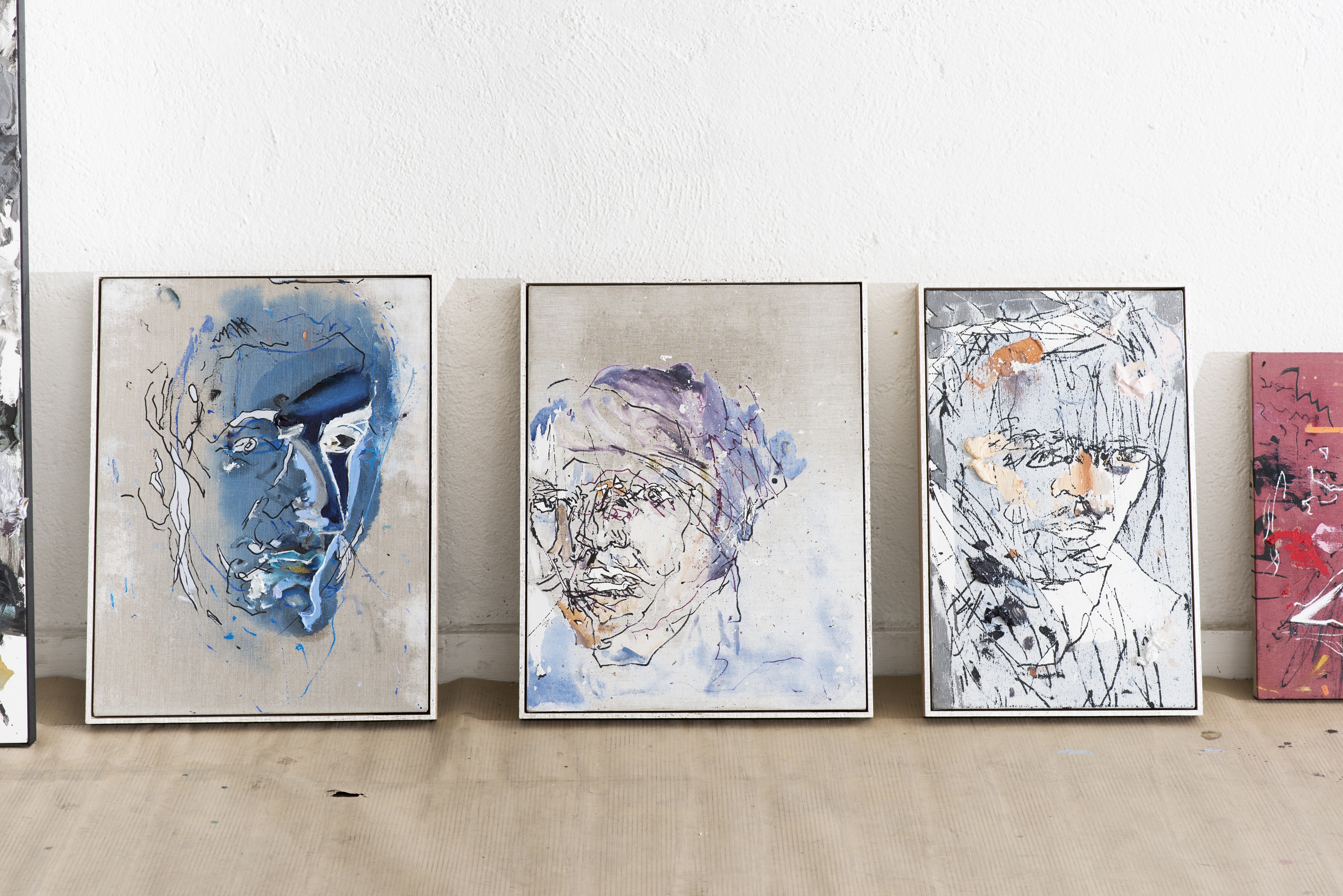
These pictures could depict politicians smiling for our vote long after an election, or musicians whose images are peeling away months after the gig has been played. In fact the portraits are of neither, but anonymous figures born in the artist’s imagination. In doing so the viewer is denied any narrative other than that of painterly process; there is no backstory to these sitters other than the backstory of their own material production: Hernández’s enduring subject. The artist will first paint the portrait, before carefully rubbing away large swathes of his labour. These parts he will partially rebuild, before further erasure, and so on until the artist is satisfied. That moment of completion occurs the second these figures appear both present and absent: they will our gaze (as all portraiture does) but retreat simultaneously, their faces disappearing into the raw uncovered canvas or falling into abstraction. In Untitled, 2016, a man in partial profile looks down plaintively. Yet we can’t be sure he’s there. Blink and those impressionistic black oil stick marks – the eyes, lips, a chin – might elude us. The barest of skin tone is suggested with pink and brown paint around the nose, one cheek and on the temple. There are some lines that might denote hair, but might just as easily be lines and nothing more. In Untitled, 2017, layers of purple and blue paint assemble into the suggestion of the subject’s hair (gender indeterminate). Yet the same tone and texture is present elsewhere in the work, used on the shoulders, and even outside this negligible face, in the background. This is the flesh of the figure and flesh of paint in collapse. A productive process in which Hernández arrives at a truth to his material.
Oliver Basciano is a writer based in London. Since 2010 he has worked at ArtReview magazine where he is currently Editor-at-Large. He also regularly contributes to the news, arts and obituary desks of The Guardian and Daily Telegraph and has authored numerous artist monographs.
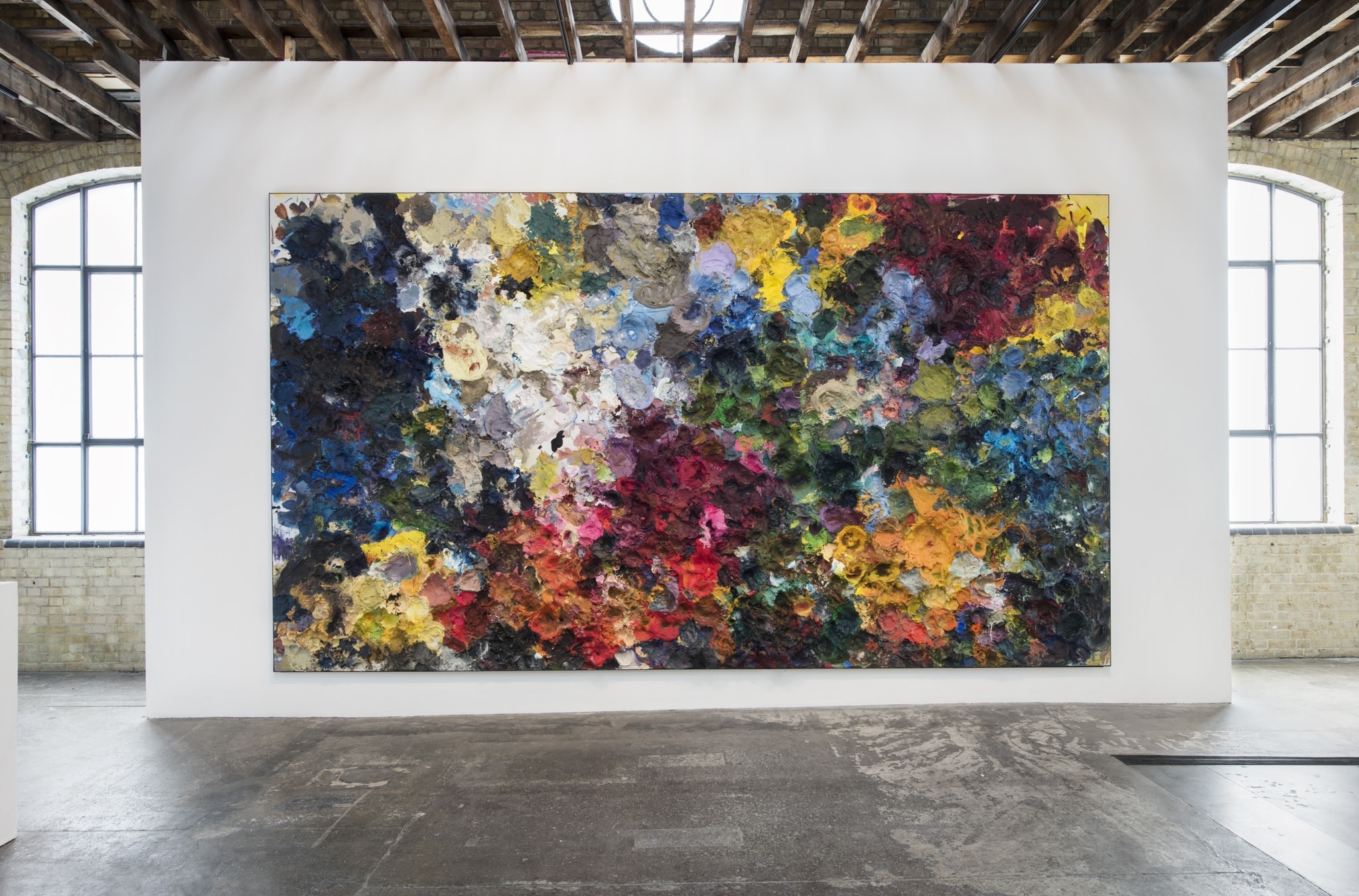
This essay was originally published to accompany the exhibition Paso. The exhibition took place across gallery locations at Mayfair and Wharf Road. At Wharf Road, Hernández showed abstract paintings that continued his investigation into gesture and form. In works on display at Victoria Miro Mayfair, figurative forms were conjured from a dynamic interplay of lines and marks.
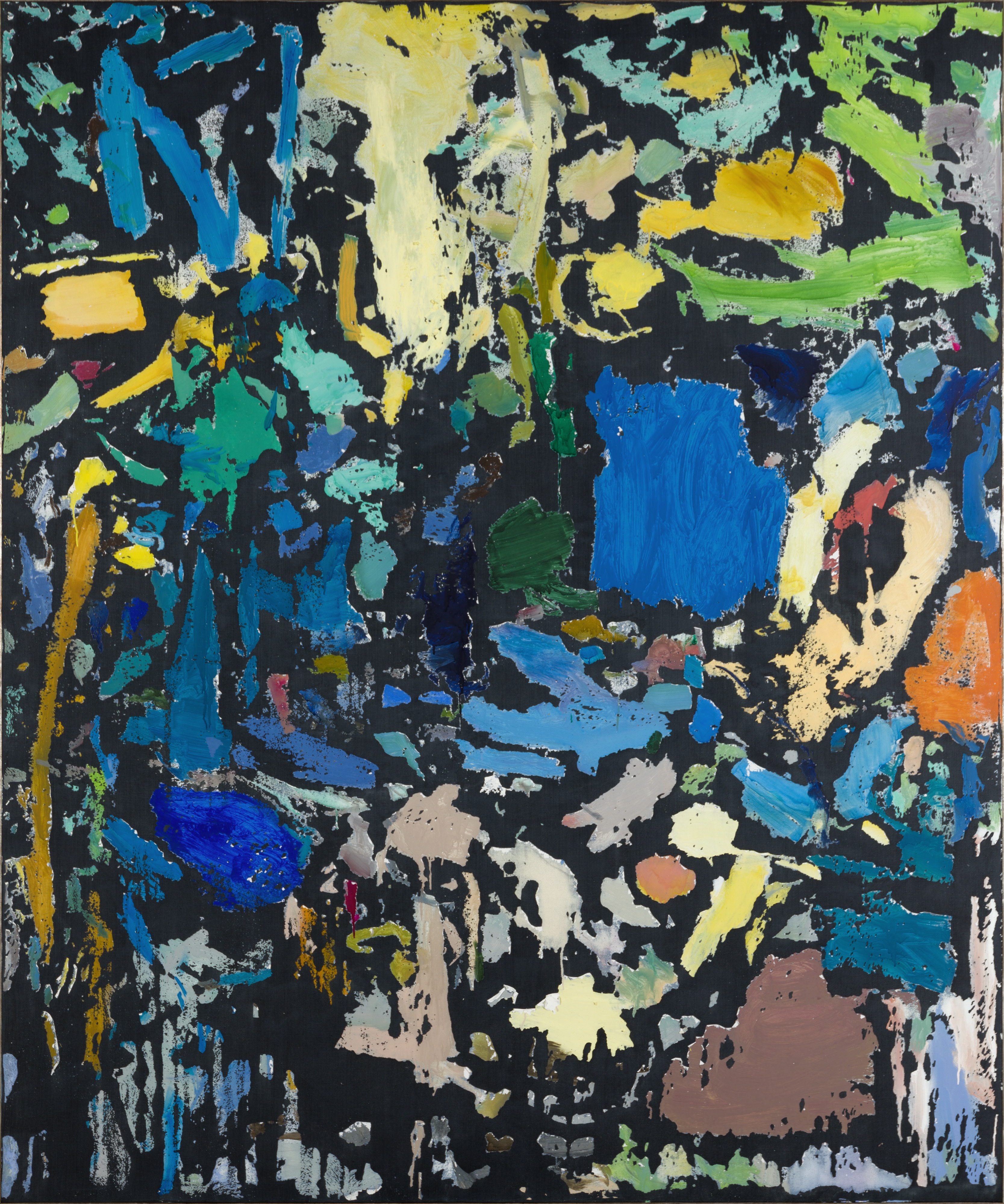
About Secundino Hernández
One of the most dynamic painters of his generation, Secundino Hernández is acclaimed for his spirited enquiry into the language, history and enduring potential of abstraction.
Secundino Hernández was born in 1975 in Madrid, where he currently lives and works. Solo exhibitions of his work have recently been presented at institutions including CAC Málaga, Spain; Taidehalli Helsinki, Finland; Yuz Museum, Shanghai and Maison Louis Carré, Bazoches-sur-Guyonne, France. His work has also been shown as part of group exhibitions at the Royal Academy, London, UK; Museo de Arte Contemporáneo Español, Madrid, Spain and Canberra Museum and Gallery, Canberra, Australia. His work is in numerous institutional and private collections, including The Rubell Family Collection, Miami, USA; Museo Patio Herreriano, Valladolid, Spain; and The Art Gallery of Ontario, Canada, among others.
An extended reality (XR) exhibition of new paintings by Secundino Hernández launches on 23 June. The exhibition is available exclusively online and via the App Store on Vortic Collect.
Images from top
Untitled, 2017
Untitled, 2017
Secundino Hernández in his Madrid studio, 2017, photograph by Thierry Bal
Untitled, 2017
Detail of work in progress in Secundino Hernández's Madrid studio, 2017, photograph by Thierry Bal
Untitled, 2017
Detail of work in progress in Secundino Hernández's Madrid studio, 2017, photograph by Thierry Bal
Untitled, 2016
Untitled, 2016
Work in progress in Secundino Hernández's Madrid studio, 2017, photograph by Thierry Bal
Installation view, Secundino Hernández, Paso, Victoria Miro, 1 April–6 May 2017. Photography: Thierry Bal
Untitled, 2020
All works © Secundino Hernández
Courtesy the artist and Victoria Miro